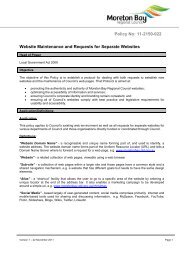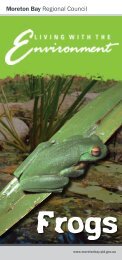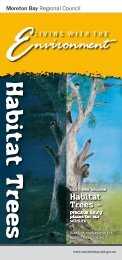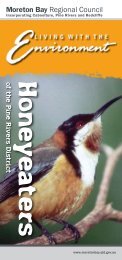South East Queensland Ecological Restoration Framework: Manual
South East Queensland Ecological Restoration Framework: Manual
South East Queensland Ecological Restoration Framework: Manual
You also want an ePaper? Increase the reach of your titles
YUMPU automatically turns print PDFs into web optimized ePapers that Google loves.
5.2.6 Avoiding damage to native plants<br />
<strong>Ecological</strong> restoration is, to a large degree, about assisting the return of structure and function to<br />
an ecosystem by reducing impacts such as weeds and encouraging the establishment of native<br />
vegetation. However in the course of weed control work, it is possible that a small number of native<br />
plants, especially small recently germinated seedlings, could be impacted. For example, while spotspraying<br />
weeds, it may be difficult to avoid herbicide affecting a few of the native seedlings. To avoid<br />
of-target damage where native seedlings are present, the site should be prepared prior to spraying by<br />
pulling back the weeds around the native seedlings. The selection of herbicide can also avoid damage<br />
to native seedlings e.g. avoid herbicides that are residual in the soil. Other precautions include, use of<br />
marker dye and correct spray nozzle, only spraying in calm dry weather and good plant identification<br />
skills. <strong>Ecological</strong> restoration attempts to reinstate a process, and if the weed control is done correctly<br />
many more native plants will germinate, survive and thrive during the restoration process. It is also<br />
important to state that haphazard spot-spraying by inexperienced operators is unacceptable.<br />
Camphor laurel conversion<br />
<strong>Restoration</strong> workers on the Far North Coast of NSW,<br />
faced with the daunting problem of large stands of<br />
camphor laurel forest replacing the original sub-tropical<br />
rainforest, have found that the weed is not as limiting<br />
to the goals of ecological restoration as first believed.<br />
In fact, when handled correctly, camphor laurel forest<br />
can be converted to sub-tropical rainforest within a<br />
surprisingly short period of time.<br />
The key to this is the fact that camphor laurel mimics<br />
the structure of a native forest, encouraging birds and<br />
mammals to continue using the forest as habitat and as<br />
a food source, dispersing seeds of many plant species as<br />
they do so. Once the camphorlaurel has been treated, abundant regeneration of native plants, coupled with timely<br />
follow-up work to control camphor seedlings, results in the prompt re-establishment of a rainforest canopy. There<br />
is still debate over whether the staged removal of the camphor laurel (controlling a proportion of the trees at a site<br />
every year over a period of years) or patch removal (treating all trees at a site simultaneously) is the better method<br />
to use. However, as with any restoration work, the control technique chosen will depend on a myriad of factors,<br />
including density of the weed, time and resources available, scope for follow-up work, topography of the site, and<br />
the potential regeneration capacity of the native vegetation. To read further on camphor conversion, access John<br />
Kanowski and Carla P. Catterall’s research at http://www.griffith.edu.au<br />
5.2.7 Skills of the bush regenerator<br />
Identification skills – of both native and weed species<br />
Take time to learn which species are present on your site. A good technique is to collect one unknown<br />
plant specimen each day in order to identify it that evening at home. There are many excellent plant<br />
references and field guides available. One of the most useful field guides is “Mangroves to Mountains”<br />
(Leiper et al., 2008) as it is very comprehensive containing photographs and brief descriptions of most<br />
of the commonly found native plant species in SEQ. Other simple plant identification keys available are:<br />
• Interactive lucid keys such as Euclid, Environmental Weeds of Australia and Wattles: Acacias of<br />
Australia, Australian Tropical Rain Forest Plants;<br />
• The [Online] Field guide to Common Saltmarsh Plants of <strong>Queensland</strong>;<br />
• Rainforest Trees and Shrubs: A field guide to their identification (Harden, et al., 2006);<br />
• Rainforest Climbing Plants: A field guide to their identification (Harden, et al., 2006); and<br />
• Plants of the Forest Floor - a guide to small native plants of subtropical eastern Australia<br />
(Watsford, 2008).<br />
SEQ <strong>Restoration</strong> <strong>Framework</strong><br />
90<br />
MANUAL



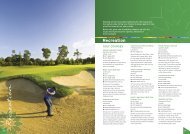

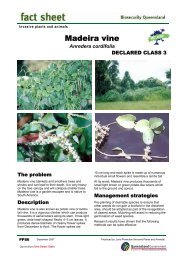
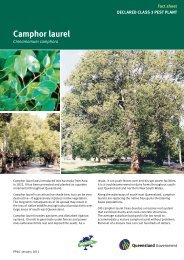


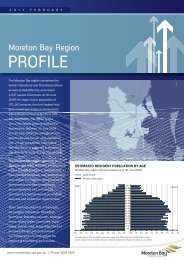
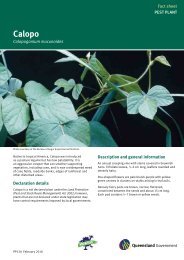

![Kumbartcho Brochure [PDF 540KB] - Moreton Bay Regional Council](https://img.yumpu.com/47220970/1/190x101/kumbartcho-brochure-pdf-540kb-moreton-bay-regional-council.jpg?quality=85)
